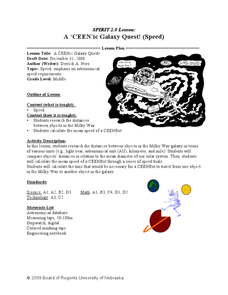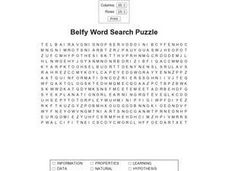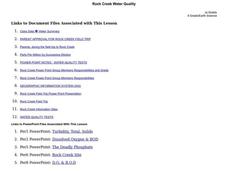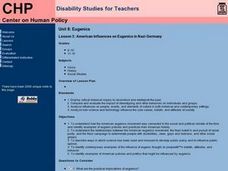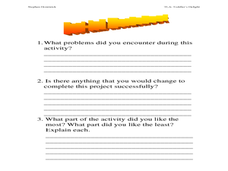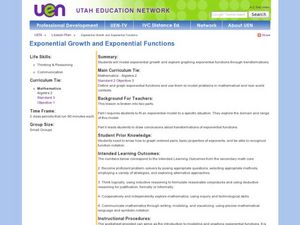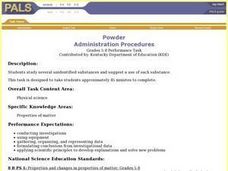Curated OER
The Pioneer Experience
Tenth graders consider the move westward. In this Westward Movement lesson, 10th graders compare and contrast the experiences of 2 pioneers by creating t-charts. Students analyze diaries, photographs, and political cartoons that capture...
Curated OER
A CEENic Galaxy Quest!
Young scholars research the distances between objects in the Milky Way. In this astronomy lesson, students calculate the time it would take for a robot to travel from Milky Way object to another. They create a travel package for...
Curated OER
Belfy Word Search
In this language arts worksheet, students study 20 words in a word bank, then locate them in a word search puzzle. The words appear to be related to chemistry but the meaning of the title is not known.
Curated OER
Black Hole Lesson
Tenth graders experiment with detection techniques for black holes by modeling the rotation of galaxies with larger and larger masses in the center. They discover while some events cannot be directly observed they may be observable in...
Curated OER
Weathering and Erosion: Some Ways the Hydrosphere Affects the Geosphere
Young scholars explain the causes of erosion, describe the effects of erosion, and devise a method of preventing erosion. They model the before-and-after-effects of erosion.
Curated OER
SURFACE CURRENTS
Students identify five major ocean currents and identify the correlation between ocean circulation and prevailing winds.
Curated OER
Rock Creek Water Quality
Ninth graders test water in a local creek using chemical kits and probes. They take GPS readings and digital photographs. They calculate the Water Quality Index and create a spreadsheet.
Curated OER
Botanical Discoveries
Sixth graders study the chronology of major events of the Lewis and Clark Expedition. They use primary and secondary resources to obtain information about the plants which were identified by Lewis and Clark.
Curated OER
American Influences on Eugenics in Nazi Germany
High schoolers examine the Eugenics movement in America. They discover the Nazi's belief in racial purity and how it relates to Eugenics. They also analyze how science has been influential in creating public policy.
Curated OER
Toddler's Delight
Students are challenged to design a toy or something that can attach to a toddler's car seat to help distract them during long car trips. Students research toddler toys prior to beginning the design process in order to determine the...
Curated OER
Refugees
Sixth graders use the internet as well as personal interviews to research refugees and refugee status from a Canadian and international perspective.
Curated OER
Where's Walden and Why Henry?
Sixth graders understand how Thoreau can serve as both inspiration and model for the investigation of home places. They explore ways to become better observers of natural and cultural history. Students find out how to connect with their...
Curated OER
What are Properties of Wood?
Students use hands on scientific observation to determine characteristics of wood. They work directly with the materials and record their observations. Students test if wood absorbs water, if wood floats or sinks, and if all wood...
Curated OER
Space Science:Wherever You Go, There You Are
Students explore navigation principles by observing, measuring, and interpreting data to determine locations. Using a compass, compass rose, and a transit, they plot courses and discover the workings of the Global Positioning System...
Curated OER
Check Out Lights and Shields with Beads
Students explore Ultraviolet detecting beads and conduct several investigations with them. In this investigative instructional activity students participate in an experiment to see the harmful effects of UV light and discuss their...
Curated OER
Exponential Growth and Exponential Functions
Students explore the concept of exponential functions. In this exponential functions lesson, students model exponential growth about a high school population using an applet. Students manipulate the applet to show the effect that a...
Curated OER
The Second Amendment and the Right to Bear Arms
Students interpret the Second Amendment. In this U.S. Constitution lesson, students examine the right to bear arms as they compare 2 Michigan Supreme Court cases and discuss their personal interpretations of the amendment.
Curated OER
The Early American Temperance/Anti-tobacco Movement
Tenth graders consider movements to regulate alcohol and tobacco use. In this Temperance Movements lesson, 10th graders compare and contrast movements in the 1800's and the modern era as they research selected primary and secondary...
Curated OER
Egypt's Uprising
Students examine the global impact of the Egyptian uprisings. In this current events lesson, students watch video clips and read articles about the role of social and traditional media in the uprising. Students also discuss the role of...
Curated OER
Ocean Exploration
Young scholars explore a simulated ocean floor. In this environmental lesson plan, students take on roles of an ocean dive team exploring the ocean floor. Dive logs will be created and the young scholars will explore their sections of...
Curated OER
Packing Materials
Students observe the effects of water on four different packing materials to determine which ones are more soluble. They then decide which material would be a good packing material to use for the environment and which may be a bad...
Curated OER
Powder
Learners investigate several unidentified substances and suggest a use of each substance. They can explain that a substance has characteristic properties, such as density, a boiling point, and solubility, all of which are independent of...
Curated OER
Classification in Action
Students work with a set of objects to set up both quantitative and qualitative classification systems. As a group, students follow an example to design and complete two classification systems using a set of objects provided. ...
Curated OER
The Big Blow
Learners identify and explain factors that contribute to extreme storms in the Great Lakes. In this investigative lesson students study the weather systems in the Great Lakes and compare cyclones to tropical storms.

